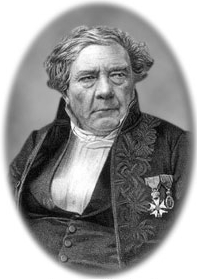Dalībnieks:Silraks/Smilšu kaste/h
| ||||||||||
| ||||||||||
| birth_place = Lusignan, France Žaks Babinets (franču: Jacques Babinet; dzimis 1794. gada 5. martā, miris 1872. gada 21. oktobrī) bija franču fiziķis, matemātiķis un astronoms, kurš ir vislabāk pazīstams par savu ieguldījumu optikā.
Biogrāfija
[labot šo sadaļu | labot pirmkodu]Viņa tēvs bija Žans Babinets un māte, Marī‐Anne Félicité Bonneau du Chesn.[1] Babinet started his studies at the Lycée Napoléon, but was persuaded to abandon a legal education for the pursuit of science. A graduate of the École Polytechnique, which he left in 1812 for the Military School at Metz, he was later a professor at the Sorbonne and at the Collège de France. In 1840, he was elected as a member of the Académie Royale des Sciences. He was also an astronomer of the Bureau des Longitudes.
Among Babinet's accomplishments are the 1827 standardization of the Ångström unit for measuring light using the red Cadmium line's wavelength, and the principle (Babinet's principle) that similar diffraction patterns are produced by two complementary screens. He was the first to suggest using wavelengths of light to standardise measurements. His idea was first used between 1960 and 1983, when a meter was defined as a wavelength of light from krypton gas.
Babinet was interested in the optical properties of minerals throughout his career. He designed and created many scientific instruments utilized to determine crystalline structure and polarization properties, including the polariscope and an optical goniometer to measure refractive indices. The Babinet compensator, an accessory useful in polarized light microscopy, was built with twin, opposed quartz wedges having mutually perpendicular crystallographic axes, and is still widely employed in microscopy. This design avoids the problems inherent in the basic quartz wedge, where the zero reading coincides with the thin end of the wedge, which is often lost when grinding the plate during manufacture.
Expanding his fascination of diffraction to meteorology, Babinet spent a significant amount of time in the study of rainbow optics. His astronomical research focused on Mercury's mass and the Earth's magnetism, while his inventions included valve improvements for air pumps and a hygrometer. In geography and hydrogeomorphology, the Baer-Babinet Law helps to explain and predict directionality in the course of rivers. Babinet's cartography work includes homalographic projections where the parallels are rectilinear and meridian lines are elliptical.
In addition to his brilliant lectures on meteorology and optics research, Babinet was also a great promoter of science, an amusing and clever lecturer, and a brilliant, entertaining and prolific author of popular scientific articles. He was beloved by many for his kindly and charitable nature.
Atsauces
[labot šo sadaļu | labot pirmkodu]- ↑ Thomas Hockey. The Biographical Encyclopedia of Astronomers. Springer Publishing, 2009. ISBN 978-0-387-31022-0. Skatīts: 2012. gada 22. augusts.
Further reading
[labot šo sadaļu | labot pirmkodu]| Vikicitātu projektā ir citātu kolekcija par tēmu. Skatīt: Silraks/Smilšu kaste/h |
- Eugene Frankel. «Babinet, Jacques». Dictionary of Scientific Biography 1. New York : Charles Scribner's Sons, 1970. 357–358. lpp. ISBN 0-684-10114-9.
Ārējās saites
[labot šo sadaļu | labot pirmkodu]{{Authority control}} {{DEFAULTSORT:Babinets, Žaks}} [[Category:Opticians]] [[Category:University of Paris faculty]] [[Category:French physicists]] [[Category:1794 births]] [[Category:1872 deaths]] [[Category:Scientific instrument makers]] [[Category:Members of the French Academy of Sciences]]

